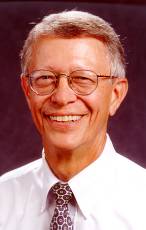Frank Cartledge

Emeritus Professor - Organic and Environmental, Alumni Professor
Bachelor's Degree(s): King College, 1960
PhD: Iowa State University, 1964
PostDoc: University of Sussex, 1964-65 -- University of Go
Phone: (225) 279-0809
E-mail: fcartledge@lsu.edu
Office: 602 Choppin
Area of Interest
The research interests in our group are in the area of environmental chemistry, particularly the treatment of hazardous wastes prior to disposal. Much of our work relates to silicate chemistry, whether it is in clays, zeolites, cements, or synthetic porous solids. Silicate structures are very common in geochemistry and in construction materials. So much Portland cement is produced each year that it amounts to more than a ton for every person living on the planet. Yet the chemistry of this system is poorly understood. It is representative of a large number of very important materials which are structurally very complex and, consequently, difficult to characterize.
Silicates are involved in such diverse waste treatment schemes as:
- Immobilization of heavy metals in cements and related binders
- Treatment of highway runoff with porous materials
- Absorption of metals or organics from wastewater with modified clays or synthetic porous solids
We carry out a collaborative research program with colleagues in engineering in order to understand the scope and limitations of these technologies. Some of the work includes practical design of waste treatment schemes and their actual implementation in the field. More commonly we are involved in the preparation and characterization of new sorptive materials and the investigation of binding mechanisms with specific wastes.
A major part of our effort employs solid-state NMR spectroscopy to characterize the bonding that is present in silicate matrices and how it may be altered by inclusion of waste materials. Portland cement is composed of silicates and aluminates, and we can look directly at the magnetically active 29Si and 27Al nuclei, which show chemical shift changes that depend on structure. In a similar manner, we look at 1H spectra and relaxation times in order to characterize water environments in the matrix, and 13C spectra in order to determine the chemical form for certain organic wastes, such as phenols. Thermal analysis and X-ray powder diffraction also may be used to determine the chemical compositions of these complex materials.
We are making increasing use of the X-ray tools made available through the CAMD synchrotron. The chemical binding of heavy metals immobilized in or on solid matrices may be characterized by X-ray absorption spectroscopy. In the figure below, XANES spectroscopy is being used to determine in situ in a solid cement sample whether chromium has been reduced successfully from more toxic Cr(VI) to less toxic Cr(III).

Furthermore, the interior composition of the materials can be visualized using X-ray
microtomography, see for example:
http://www.chem.lsu.edu/lucid/butler/Tomo/index.html
The aim of this environmental work is to be able to predict the long‑term behavior of treated hazardous wastes and to derive clues to the design of more successful immobilizing agents. The work has important spin-offs for understanding cement chemistry and the design of cement-containing materials that have properties different from that of standard concrete used for civil engineering construction. There has been a substantial rebirth of interest in this "low tech" material, including the establishment of a Center for Science and Technology of Advanced Cement-Based Materials by the National Science Foundation.
Selected Publications
J.D. Eusden, Jr., L. Gallagher, T.T. Eighmy, B.S. Crannell, J.R. Krzanowski, L.G. Butler, F.K. Cartledge, E. Emery, E.L. Shaw and C.A. Francis. Petrographic and Spectroscopic Characterization of Phosphate-Stabilized Mine Tailings from Leadville, Colorado. Waste Management, 2002, 22, 117-35
Dweck, P.M. Buchler and F.K. Cartledge. The Effect of Different Bentonites on Cement Hydration during Solidification/Stabilization of Tannery Wastes. J. Therm. Anal. Calorimetry, 2001, 64, 1011-1016
Liu, Z. Teng, F.K. Cartledge and J.J. Sansalone. Surface Characteristics of Sorptive-Filtration Storm Water Media. Part 1: Low Density (ps<1.0) Oxide Coated Buoyant Media. J. Environ. Engr., 2001, 127 (10), 868-878
Akhter, F.K. Cartledge, J. Miller and M. McLearn. Treatment of Arsenic-Contaminated Soils Part 1: Soil Characterization. J. Environ. Engr., 2000, 126, 999-1003
Miller, H. Akhter, F.K. Cartledge and M. McLearn. Treatment of Arsenic-Contaminated Soils Part 2: Treatability Study and Remediation. J. Environ. Engr., 2000, 126, 1004-1012
Dweck, P.M. Buchler, A.C.V. Coelho and F.K. Cartledge. Solidification/Stabilization of a Tannery Waste with Blended Cement and Wyoming Bentonite. J. Environ. Sci. Health, 2000, A35, 715-740
L.G. Butler, J.W. Owens, F.K. Cartledge, R.L. Kurtz, G.R. Byerly, A.J. Wales, P.L. Bryant, E.F. Emery, B. Dowd and X. Xie. Synchrotron X-ray Microtomography, Electron Probe Microanalysis, and NMR of Toluene Waste in Cement. Environ. Sci. Technol., 2000, 34, 3269-75
Anderson, A. Roy, R.K. Seals, F.K. Cartledge and H. Akhter. A Preliminary Assessment of the Use of an Amorphous Silica Residual as a Supplementary Cementing Material. Cem. Concr. Res., 2000, 30, 437-445
Dweck, P.M. Buchler, A.C.V. Coelho and F.K. Cartledge. Hydration of a Portland Cement Blended with Calcium Carbonate. Thermochimica Acta,2000, 346, 105-113
T.T. Eighmy, B.J. Crannell, J.E. Krzanowski, L.G. Butler, F.K. Cartledge, E. Emery, J.D. Eusden, Jr., E.L. Shaw and C.A. Francis. Characterization and Phosphate Stabilization of Dusts from the Vitrification of MSW Combustion Residues. Waste Management, 1999, 18, 513-524
L.G. Butler, F.K. Cartledge, J.W. Owens and B. Dowd. Synchrotron X-ray Microtomography and Solid-State NMR of Environmental Wastes in Cement. SPIE: Developments in X-Ray Tomography II, 1999, 3772, 97-104